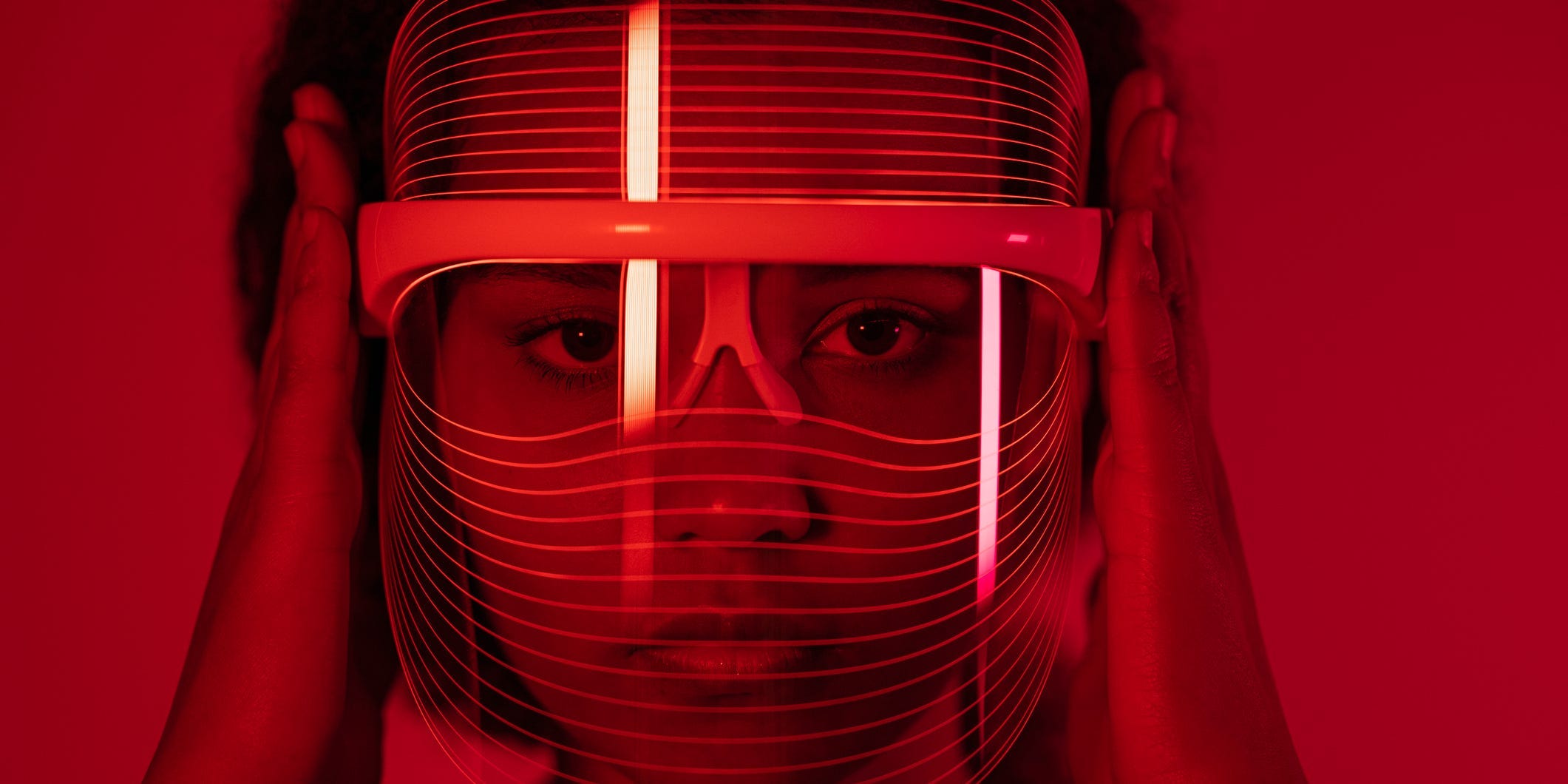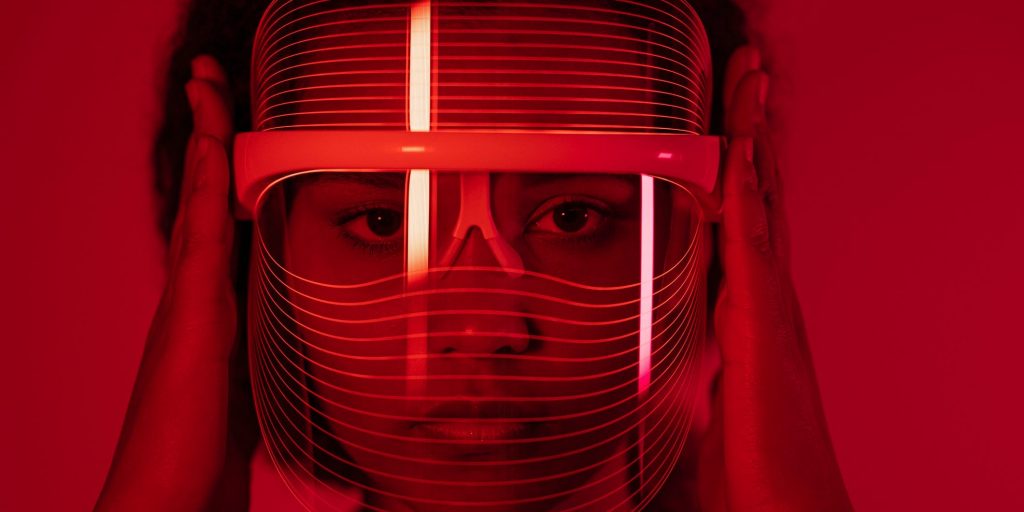
- Red light therapy may be beneficial because it boosts production of ATP which may enhance healing.
- Because it can also reduce inflammation, it may help conditions like arthritis and acne.
- Red light may also help decrease signs of aging by replenishing the collagen in your skin.
- Visit Insider's Health Reference library for more advice.
Perhaps you've heard celebrities raving about the benefits of red light, or seen advertisements on Instagram for expensive red-light emitting devices.
Red light therapy is a treatment that uses LED lights or lasers to expose the body to red light, the longest wavelength of visible light on the visible light spectrum. It's sometimes referred to as RLT, photobiomodulation therapy, or low-level laser light therapy.
Some research suggests that exposing yourself to red light for 5 to 20 minutes may increase the production of adenosine triphosphate (ATP,) a compound that stores and provides energy to your cells.
That increase in cellular energy can be beneficial when it comes to repairing skin damage and wound healing, says Laura Buford, MD, a dermatologist at Westlake Dermatology & Cosmetic Surgery.
"While more research is needed to understand the full benefits and mechanisms of red light therapy, there is evidence to suggest it may be beneficial in improving certain skin conditions including acne, aging, hair loss, wound care, and sun damage," Buford says.
Here are six potential benefits of red light therapy.
1. Reduce inflammation
Inflammation is a process that helps your body fight infection and heal — but chronic inflammation that lingers in the body is linked to a range of disorders including:
- Diabetes
- Heart disease
- Cancer
- Depression
- Bowel diseases
In animal studies, red light therapy has been shown to reduce inflammation by decreasing levels of inflammation-causing molecules called pro-inflammatory cytokines.
2. Improve acne
Light-based and laser therapies are often used to treat acne because the light can penetrate deep within the skin.
Red light targets your sebaceous glands — small ducts that release a pore-clogging, acne-causing oil called sebum. The effect of the light helps reduce inflammation within those sebaceous glands, which may improve the appearance of acne.
Some research suggests that red light appears to be most effective as an acne treatment when used with a type of drug called a photosensitizing agent — particularly among patients whose acne doesn't respond to topical therapy or oral antibiotics. One over-the-counter photosynthesizing agent is alpha-lipoic acid (ALA).
You should know that photodynamic therapy can make you more sensitive to light for as long as three months post-procedure. Other possible side effects include:
- Swelling at the area of skin treated
- Skin discoloration
- Scales crusts or blisters
- Itching or burning
- Skin infections
3. Decrease signs of aging
Your skin is largely made of collagen, a protein that prevents it from sagging and keeps it looking and feeling plump. While collagen is naturally produced by the body, sun exposure, smoking, pollution exposure, and aging decrease production causing skin to lose elasticity and appear to sag and wrinkle.
A 2014 study found full-body exposure to red light over the course of 30, twice-a-week sessions increased collagen density on participants' faces and caused visible improvements in wrinkles and skin roughness.
4. Reduce pain from arthritis
Red light therapy could help reduce pain from a couple types of arthritis:
- Osteoarthritis: a degenerative disease that affects the fingers, knees, and hips.
- Rheumatoid arthritis: an autoimmune condition causing inflamed joints.
Recent human studies are limited. One small study from 1992 found that red light therapy led to a more than 50% reduction in arthritis pain from patients with degenerative osteoarthritis in both knees.
A more recent 2013 study in rats found similar results that low-level laser light reduced inflammation in knee joints with osteoarthritis. However, the researchers note that more thorough research is necessary before light therapy can be recommended as a "valid therapy."
5. Promote wound healing
While research on adult humans is limited, animal and in-vitro studies suggest red light can accelerate the healing process of cutaneous wounds.
Studies have found treating wounds with red LED light:
- Reduction in inflammatory cells
- Increased fibroblasts (connective tissue cells that produce collagen and fibers)
- Collagen synthesis
- Angiogenesis (new blood vessel formation) and tissue formation
All of the above are involved in the wound healing process.
6. Boost hair growth
Androgenetic alopecia, a genetic condition that causes hair loss, is the most frequent cause of hair loss in both males and females, affecting an estimated 80 million people in the United States.
A small 2013 study found that laser light therapy using red light significantly improved hair counts in males with androgenetic alopecia. In the study, participants were treated every other day for 16 weeks, for a total of 60, 25-minute long sessions.
Insider takeaway
Red light therapy is a treatment involving exposing the body to red light using LED lamps or lasers. While some of the data on red light appears promising, more studies are needed to determine exactly how red light works, and how it can most benefit patients.
"Results vary from patient to patient and are typically subtle after one session," Buford says. "More research is needed to further characterize the benefits of red light therapy, but it appears to be a promising treatment in the field of dermatology."
